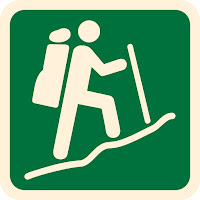 |
| Walk Trail information sign at Walyunga National Park with walks rated by Class |
Walk Trails in Australia are rated for difficulty under the Australian Walking Track Grading System (AWTGS) - a voluntary industry standard designed to technically grade walking trails and to communicate this information to potential walkers. This is a great system as it provides a national standard by which walk trails can be judged, so two trails of similar difficulty in two different states can be rated on the same scale.
Below are the descriptions of the 5 Classes used in the AWTGS and their corresponding symbols (WA seems to use slightly different but easily interchangeable symbols, including a separate class 6 symbol):
Class 1
No bushwalking experience required. Flat even surface with no steps or steep sections. Suitable for wheelchair users who have someone to assist them. Walks no greater than 5km.
Class 2
No bushwalking experience required. The track is a hardened or compacted surface and may have a gentle hill section or sections and occasional steps. Walks no greater than 10km.
Class 3
Suitable for most ages and fitness levels. Some bushwalking experience recommended. Tracks may have short steep hill sections a rough surface and many steps. Walks up to 20km.
Class 4
Bushwalking experience recommended. Tracks may be long, rough and very steep. Directional signage may be limited.
Class 5/6
Very experienced bushwalkers with specialised skills, including navigation and emergency first aid. Tracks are likely to be very rough, very steep and unmarked. Walks may be more than 20km.
The difficulty of the walks are judged under the following criteria: Distance, Gradient, Quality of Path, Quality of Markings, Experience Required, Time and Amount of Steps. The walk gets its grading from its hardest component, and this is where I sometimes feel that the information given out to the public can fall short.
 |
| Talyuberlup Peak in the Stirling Ranges requires scrambling to reach the summit. |
I personally look for walks that have some degree of difficulty - either in terms of kilometres or terrain. That being said, other than the Stirling Ridge Walk, I am not particularly interested in cross-country free walking or walks that require significant map, compass or GPS usage as I prefer to be able to walk on a relatively discernible path without having to constantly be checking coordinates. Likewise, if the walk heads into canyoning or serious rock climbing territory, I might be interested but will require specialist equipment and training I just don't have at the moment.
 |
| The Granite Skywalk requires climbing over natural obstacles with the help of metal rungs |
Therefore, for me it is important to know why a trail is rated as 4, 5 or 6 - am I undertaking an almost completely flat 40 kilometre loop like the the Railway Reserves Heritage Trail, a short walk with a brief climbing/scrambling section like the Granite Skywalk, trying to discern a terribly overgrown trail like Kattamordo, descending with ropes into Red Gorge at Karijini National Park or following an unmarked route like the Stirling Ridge Walk? All would be at least a Class 4 Track, but they are of vastly different difficulty and for vastly different reasons.
 |
| The Kattamordo Heritage Trail has fallen into disrepair and can be difficult to discern. Note incorrect spelling |
Because of this, I have opted to not give walk trails a Class Rating from 1 to 6; I have instead provided brief information about each of the criteria by which the walk is judge so you can make decisions based on your own strengths, weaknesses and preferences. While the Class numbers are good for dissuading people from tackling a trail beyond their skill levels or fitness, I think more detailed information is far more useful to walkers than a simple number system when it comes to harder walks. And really, I take it if you're scouring the internet for bushwalking information you're the kind of person who would appreciate this kind of breakdown anyway. It is to me the best part about the Australian Walking Track Grading System, as their criteria basically answer all the questions one might have about what kind of walk they are undertaking.
















0 comments:
Post a Comment